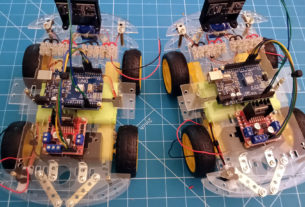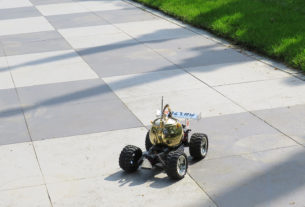Our twin robots – A.R.T.I. 3 (Aneira) and A.R.T.I. 4 (Eirlys) – were the stars of the show on our display at BeachLab:relocated (2021), at Aberystwyth University last year. We use the twins for most of our demonstrations; they’re reliable, always fully charged, and their speed usually gets a pleasing reaction from onlookers while still being predictable enough to catch them. The fact they look almost identical is also something that people find fascinating (more about why we did that HERE).
We used them both a lot that day and at some point in the day, both of the twins stopped working properly. We figured that they were just lacking a decent charge so we put them both on charge, and continued the day using our other A.R.T.I. bots for the demonstrations when talking to the public.
When we got home, we diagnosed them. While we were right that #4 was lacking charge, #3 wasn’t in the best of health. One of the cogs, in one of her four gearboxes had broken. The cogs in the yellow gearboxes that we’ve used for three of our A.R.T.I. bots (including the twins) are made of plastic, so they wear out fairly quickly and are prone to snapping, as we’ve experienced. Especially on 4WD robots, with a lot of grip, on a surface like tarmac.
We decided that we had two options: replace only the one gearbox with another yellow gearbox (with plastic gears still), or get eight blue gearboxes (with metal gears), and replace all the gearboxes on both of the twins. We chose the latter.
We’ve always tried to make the twins look as identical as we possibly could, and we felt that only one of them having shiny new gearboxes would make them look too dissimilar. For this reason, we felt it would look better if both of them received the upgrade.
They absolutely needed replacing and we ended up finding blue gearboxes from the same people who make the yellow ones. The blue gearboxes are more expensive than their yellow counterparts, but an important distinction is that the cogs inside are made of metal instead of plastic. This naturally means that it should take longer for them to wear down and they shouldn’t snap quite as easily.
We put them on, and got them all soldered up and got to test driving them. They’re now fractionally slower than they were before, which makes them more suitable to demonstrate how they work. They also now make some very lovely mechanical noises when moving, which is beautifully satisfying.
Cerys
#RoboticsIsForEveryone



